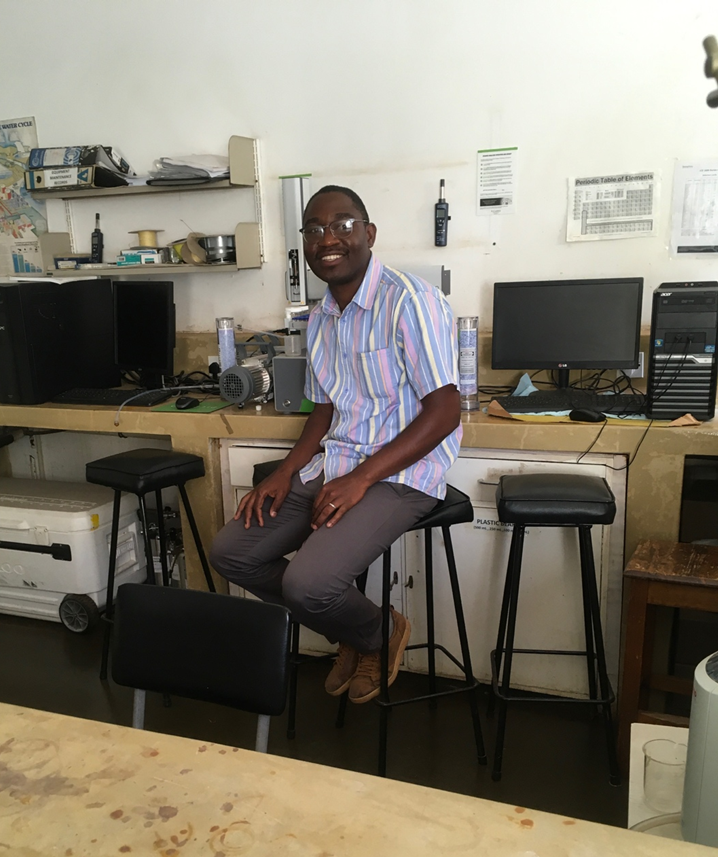News
Current Student Profile: Onesmus Kativhu from Zimbabwe

Onesmus Kativhu lives on the outskirts of Harare, Zimbabwe, where he works as a technician in the teaching laboratory at the University of Zimbabwe. He works with students in the Construction and Civil Engineering Department, teaching chemistry and at times carrying out water quality testing. His students are “enthusiastic, eager to learn,” he says; “most of them are hands-on and want to learn”. Onesmus is also a student himself however: he is currently taking an accredited Continuous Professional Development course online with the UNEP GEMS/Water Capacity Development Centre, housed at the Environmental Research Institute in the School of Biological, Earth and Environmental Sciences at University College Cork, Ireland. As both a teacher and a student, Onesmus is a shining example of how capacity development in water quality monitoring can benefit from a ‘train the trainers’- type approach.
The challenges that Zimbabwe faces with respect to water quality are familiar to those in the global water sector, but of course also particular to the environmental and social conditions of the region. Zimbabwe’s surface water situation is dominated by its bimodal climate: a wet season from November to April brings significant rain, while the winter is typically dry. Reservoirs catch and store much of the rainwater, but many of the catchment areas around Harare are devoted to agriculture, livestock, industry, and urban development. This negatively impacts the quality of surface waters, and high levels of nitrates are a particular problem in water bodies around Harare. Moreover, the original vegetation of the region has largely been removed in favour of fields, pastures, roads and buildings, so that soil erosion is a serious problem. The reduced groundcover also means that when heavy rains come, the ground absorbs less of the water and flooding is more likely.

Onesmus taking a sample of groundwater from a local borehole.
The city of Harare has grown substantially in recent decades, and its aging water infrastructure has generally not kept pace with this expansion. Onesmus explains that, with a range of pollutants present in surface water bodies, available ambient water supplies now require expensive treatments to supply safe drinking water; and this has led to rationing and intermittent supplies of piped water at times. Moreover, in many areas around Harare, recent developments of homes and businesses have gone ahead without provision for water supply, or adequate sewage treatment.
All of these factors together mean that groundwater sources have been increasingly explored in and around Harare. This in fact brought Onesmus into water monitoring in the first place: while he was working at the University of Zimbabwe, the intermittent supplies of piped water led the University to explore the supply of groundwater. They drilled boreholes and built storage tanks, and Onesmus found a position testing the quality of the resulting water. This led to his current position in the teaching laboratory.
Faced with the same problems of intermittent supplies, “people have to arrange their lives around the availability of water.” Many residents of Harare have been forced to accommodate themselves to alternating days with and without water, and some resort to purchasing bottled water and bulk supplies of borehole water. Many more are making the same choices as the University and drilling their own wells. In some cases, there can be many boreholes quite close together, often done in an uncoordinated manner. Onesmus describes as many as twenty on a single city block, and “there are [required] permits, but people go around the system.” This can lead to rapid withdrawal of the groundwater and unsustainable extraction.
In tandem with groundwater extraction, there are also other considerations that impact Harare’s water supplies due to wastewater treatment facilities. The city’s system of removing wastewater matches its system of piped water provision, and thus many households have resorted to septic tanks. These can then be as densely packed as the boreholes, and, as Onesmus points out, “there is a danger of [shallow wells] being recharged from septic tanks.” That can lead directly to water-borne illnesses like cholera.
Addressing these problems requires a number of measures: for example, infrastructure ought to be updated, improved, and expanded, so that problems with water quality are prevented rather than treated once they have occurred and done damage. But, as Onesmus explains, ultimately the problem also comes down to a lack of local expertise. He points out that there is only one college offering training in water quality monitoring.

Water infrastructure in and around Harare. Clockwise from top left: a wellhead; water storage tanks at the University of Zimbabwe; water spilling over the dam at a local reservoir; a small spring.
This is why Onesmus has turned to training through the UNEP GEMS/Water CDC : online training can help engaged individuals like Onesmus to develop their expertise in this field, and then pass this on to their students. He is currently enrolled in a course in freshwater monitoring programme design but plans to work his way through other continuous professional development courses. Ultimately, he has his sights set on an MSc in Freshwater Quality Monitoring and Assessment, a qualification that would give him the expertise to support a much more robust water monitoring programme in and around Harare. By utilising a ‘train the trainers’ approach to training and education around water quality, individuals like Onesmus can act as multipliers, propagating knowledge of water quality monitoring and working toward a better future.
